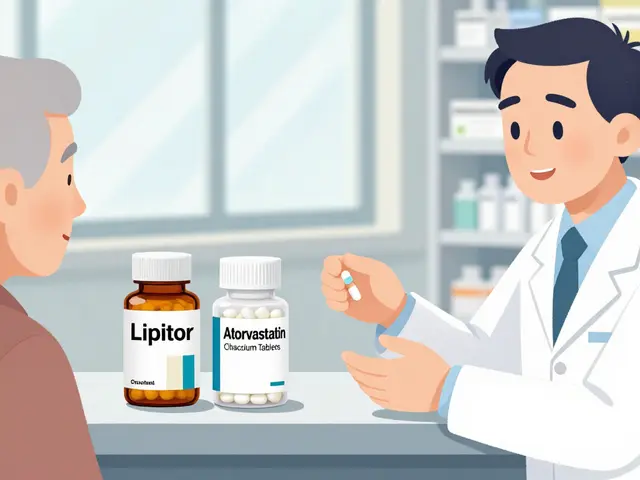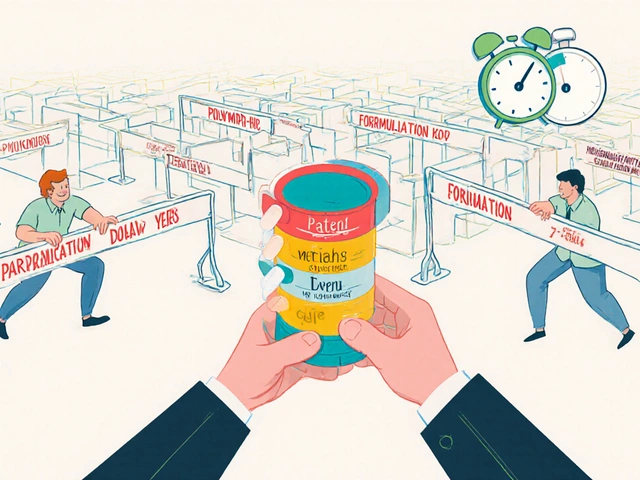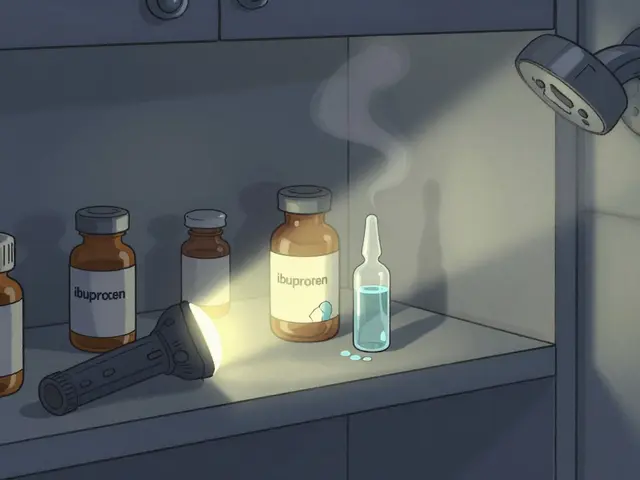If your ears ring harder when your nose blocks up, you’re not imagining it. Allergy flares can tighten the Eustachian tube, trap pressure behind the eardrum, and make tinnitus feel louder. There isn’t a single cure, but you can lower the volume by treating the rhinitis first, easing ear pressure, and using a few tinnitus‑specific tools. Expect steady gains over 2-4 weeks, not overnight miracles.
- TL;DR
- Target the nose first: daily intranasal steroid + non-drowsy antihistamine during allergy days.
- Protect the ear: open the Eustachian tube (saline rinse, steam, gentle pressure maneuvers), and keep steady background sound at night.
- Skip long runs of oral decongestants; they can spike ringing and blood pressure.
- Track patterns for 14 days; if tinnitus stays unilateral, pulsatile, or hearing drops, book an ear/hearing check promptly.
- CBT-based tinnitus programs and hearing aids (if you have hearing loss) reduce distress and loudness perception.
What’s Going On, and the Quick Wins That Actually Help
Allergies inflame the lining of your nose and the small tube that drains your middle ear. When that tube (the Eustachian tube) swells shut, pressure builds, your eardrum can pull inward, and the brain hears more of the internal noise it usually tunes out. Add poor sleep and jaw clenching from mouth breathing, and tinnitus gets center stage.
Here’s the useful bit: calming the nose and freeing the tube often lowers tinnitus intensity. Think of it as fixing the plumbing upstream before you fiddle with the tap.
What you can do today:
- Use a steroid nasal spray daily in season (fluticasone, budesonide, mometasone). Relief starts in 6-12 hours; best effect takes 1-2 weeks. Aim the nozzle outwards (toward your ear), not at the septum, and take a gentle sniff so medicine stays in the nose.
- Add a non-drowsy antihistamine on heavy pollen/dust days (fexofenadine, cetirizine, loratadine, bilastine). These help sneezing/itching more than stuffiness, but they support the steroid.
- Rinse with saline once or twice daily. It flushes allergens, thins mucus, and reduces the pressure felt behind the eardrum.
- Use sound enrichment at night (fan, white noise, soft nature sounds). Silence makes tinnitus shout.
- Unclench the jaw. Nasal blockage pushes you to mouth-breathe and clench. Short jaw stretches and tongue-to-palate posture can ease somatic tinnitus.
- Go easy on oral decongestants. Pseudoephedrine and phenylephrine can raise tinnitus for some people; if you use them, keep it short (no more than a few days) and not late in the day.
What does the science say? ENT societies point people with rhinitis to intranasal steroids as first-line. Allergy organizations back saline rinses to cut symptoms and medication use. For tinnitus, hearing aids help when hearing loss is present. Cognitive behavioral therapy (CBT) doesn’t silence tinnitus but consistently reduces how much it bothers you, based on randomized trials and a large Cochrane review. Sound therapy is modest but practical for sleep and focus.
Seasonal reality check: in southern Australia, grass pollens ramp up from October through December, with erratic high counts starting in September. If you’re in Melbourne, you know the drill-windy spring days and “thunderstorm asthma” warnings. On high-pollen days, close windows by late morning, shower after being outside, and pre-dose with your nasal spray. If you’re elsewhere, follow your local pollen calendar-it’s the same idea, different months.
Medication options and how they interact with tinnitus and pressure-at a glance:
| Option | What it treats | Onset | Common side effects | Tinnitus impact | Notes |
|---|---|---|---|---|---|
| Intranasal steroids (fluticasone, budesonide, mometasone) | Congestion, drip, itching | 6-12h; best at 1-2 weeks | Nasal dryness, minor nosebleeds | Often lowers by fixing ET dysfunction | Daily use in season; correct angle matters |
| Oral non-drowsy antihistamines (fexofenadine, cetirizine, loratadine, bilastine) | Sneezing, itch, drip | 1-3h | Dry mouth; cetirizine can cause slight drowsiness | Neutral; can help if allergies drive tinnitus | Take on high-allergen days or daily in season |
| Intranasal antihistamine (azelastine) | Rapid itch/sneeze relief | 15-30 min | Bitter taste | Neutral | Good add-on for breakthrough symptoms |
| Oral decongestants (pseudoephedrine) | Short-term stuffiness | 30-60 min | Jittery, insomnia, ↑BP/HR | Can worsen in some users | Limit to a few days; avoid late doses |
| Topical decongestant sprays (oxymetazoline) | Fast relief | 5-10 min | Rebound congestion if >3 days | Variable | Max 3 days to avoid rebound |
| Leukotriene blockers (montelukast) | Allergic rhinitis + asthma | Daily use | Sleep/mood effects in rare cases | Neutral | Specialist advice if asthma overlaps |
| Allergen immunotherapy (shots or tablets) | Underlying allergy | Months | Local itch/swelling; rare systemic reactions | Indirectly helps by preventing flares | For proven, significant allergies |
| Hearing aids | Hearing loss + tinnitus | Immediate | Adaptation period | Often lowers perceived loudness | Get an audiogram first |
| CBT-based tinnitus therapy | Tinnitus distress | Weeks | Requires practice | Reduces bother and improves sleep | Strong evidence; delivered online or in person |
Authoritative sources that support the above include ENT and allergy guidelines (American Academy of Otolaryngology-Head and Neck Surgery, European Position Paper on Rhinosinusitis and Allergies, Australasian Society of Clinical Immunology and Allergy), the National Institute on Deafness and Other Communication Disorders on tinnitus basics, and Cochrane reviews on CBT for tinnitus and intranasal steroids for allergic rhinitis.
Quick safety notes:
- If you’re pregnant, planning pregnancy, or breastfeeding, ask your doctor before starting or changing any meds. Many nasal steroids are considered safe; confirm which one.
- High blood pressure, arrhythmia, glaucoma, prostate issues? Avoid or limit decongestants.
- Children: no pressure “popping” maneuvers that cause pain; stick with saline, correct sprays, and pediatric advice.

A 14‑Day Plan to Calm Allergy-Driven Tinnitus
This is a practical routine you can follow now. It blends allergy control, ear pressure care, and tinnitus coping. Adjust doses to your local labels and your doctor’s advice.
Day 0: Baseline and setup
- Rate your tinnitus 0-10 for loudness and 0-10 for bother. Note ear fullness, popping, and hearing clarity.
- List obvious triggers: mowing the lawn, windy days, house dusting, pet time, red wine, late coffee.
- Prepare gear: saline rinse bottle or neti pot with sterile water, intranasal steroid, a non-drowsy antihistamine, a white-noise app or bedside fan.
Days 1-3: Open the nose, protect the ear
- Morning: saline rinse (isotonic), then 1-2 sprays of steroid into each nostril. Technique: chin slightly tucked, nozzle angled outward, spray while breathing out, then a gentle sniff. Avoid a hard sniff that drags medicine to your throat.
- Take a non-drowsy antihistamine if pollen/dust exposure is likely today.
- Use steam (shower or bowl) for 5-10 minutes if you feel stuffed; follow with a gentle Valsalva only if it’s comfortable: mouth closed, pinch nose, blow gently till ears pop, no pain.
- Daytime: sip water often, limit late caffeine, and keep a soft sound bed when working in a quiet room.
- Night: a fan or sound machine at low volume; avoid silence. Aim for 7-8 hours of sleep.
Days 4-7: Fine-tune
- If itch/sneeze breakthrough continues, add an intranasal antihistamine (like azelastine) in the evening.
- If you reached for an oral decongestant, keep it to daytime and for no more than 2-3 days. Notice any tinnitus spikes; if it worsens, stop it.
- Jaw and neck routine twice a day: slow jaw openings (5 reps), tongue up to the palate and slide back (5 reps), neck side stretches (20 seconds each side). Many people with blocked noses clench-this quiets somatic input to the ear.
- Short, steady cardio (brisk walk 20-30 min) most days. Better sleep and circulation make tinnitus less intrusive.
Days 8-14: Lock in habits and escalate if needed
- Keep daily steroid spray. If you haven’t noticed any gain by day 10, check technique. Most misses are from aiming at the septum or sniffing too hard.
- Still feeling blocked? Try a hypertonic saline rinse once daily for a few days, then return to isotonic.
- Schedule an audiology hearing test and tympanogram if any of these are true: tinnitus is only in one ear, you’ve had pressure/fullness for more than 2 weeks, or you notice hearing changes.
- Start a brief CBT-based tinnitus exercise: 10 minutes of noticing tinnitus without judgment while breathing slowly, then shift attention to a neutral sound (fan, white noise). Do this daily. It trains your brain to stop tagging the sound as a threat.
- Review your 14-day diary. If tinnitus tracks with allergy days (and ear fullness), you’re on the right path-keep the allergy plan through your season.
Decision rules to keep you safe:
- Urgent care now if you have sudden hearing loss, spinning vertigo, facial weakness, severe ear pain with fever, or tinnitus that throbs with your heartbeat (pulsatile).
- Book an ENT/audiology visit within 2-4 weeks if tinnitus is only in one ear, you have ongoing ear fullness, or your hearing test is abnormal.
Allergy control checklist (pin this on your fridge):
- Daily steroid spray in season; correct angle and a gentle sniff.
- Saline rinse once or twice a day-sterile or boiled and cooled water only.
- Antihistamine on high-exposure days; carry it in your bag.
- Windows closed on windy, high-pollen afternoons; shower and change after outdoor work.
- Vacuum with HEPA weekly; dust with a damp cloth; wash bedding hot weekly if dust-mite sensitive.
- Pets: keep them out of the bedroom during peak season; wipe their coat after outdoor time.
Ear pressure relief routine (2-3 times daily during flares):
- Steam or a warm compress over the nose/cheeks for 5 minutes.
- Saline rinse.
- Nasal steroid (or antihistamine spray if prescribed) with proper technique.
- Gentle pressure equalization-only if painless.
Medication safety rules of thumb:
- Oral decongestant: max a few days; avoid if you have uncontrolled hypertension, heart rhythm problems, or trouble sleeping.
- Topical decongestant spray: max 3 days to avoid rebound blockage.
- Antihistamine: if drowsy on cetirizine, try fexofenadine or bilastine.
- Nasal steroids: if nosebleeds occur, pause for 24-48 hours, use saline more, aim outward, restart gently. Switch brand if needed.
What about food and supplements?
- Alcohol (especially red wine) and big caffeine hits can make tinnitus feel louder for some. Try a two-week swap: earlier coffee, less red wine, more water.
- Ginkgo, zinc, and similar supplements haven’t shown consistent benefit in good studies for tinnitus. Magnesium may help sleep and muscle tension in some people but isn’t a tinnitus cure.
Backed-by-evidence extras:
- CBT reduces tinnitus distress and improves quality of life. Trials show meaningful drops on the Tinnitus Handicap Inventory. It’s not about “thinking happy thoughts”-it retrains attention and lowers the threat response.
- Hearing aids often reduce tinnitus loudness when hearing loss is present. They restore input the brain was missing, which dials down the internal noise gain.
- Allergen immunotherapy is the only allergy treatment that changes the disease course. If your testing confirms a strong trigger (e.g., grass pollens, dust mites) and symptoms are rough each year, ask for a referral.

FAQ, Troubleshooting, and Next Steps
Mini‑FAQ
- Can antihistamines make tinnitus worse? Most non-drowsy ones are neutral or helpful indirectly by cutting allergy flares. First-generation antihistamines (diphenhydramine) can dry you out, make you sleepy, and occasionally make perception worse. If you notice a spike, switch to a different class.
- Will steroids cure my tinnitus? Nasal steroids treat the allergic nose and Eustachian tube swelling. That can lower tinnitus in allergy-driven cases. They won’t cure chronic, non-allergy tinnitus.
- Is earwax part of this? Wax and allergies are separate, but a blocked nose plus poor Eustachian function can make mild wax feel like a full block. Don’t use cotton swabs or ear candles. If you suspect wax, get it checked and removed safely.
- Do pressure-equalizing exercises help? Gentle ones can. If it hurts or makes you dizzy, stop. Pain is your sign to back off.
- Are “tinnitus supplements” worth it? There’s no consistent evidence they work. Spend your money on proven stuff: nasal treatment, sound therapy, CBT, and hearing care.
- Can allergy shots help tinnitus? Indirectly, yes-by reducing allergy flares that drive Eustachian tube dysfunction. It’s a long game (months to years), but it changes the terrain.
- What about new devices and neuromodulation? Sound-and-stimulation devices exist. Evidence is mixed and evolving. If you’re curious, discuss with a tinnitus clinic after you’ve nailed the basics.
- Is it normal for tinnitus to be louder at night? Yes. Fewer outside sounds and a tired brain make it feel louder. Use a steady, low-level sound bed and a wind-down routine.
- Flights and allergy ears? Dose your nasal steroid that morning, use saline pre-boarding, chew or sip during ascent/descent, and perform gentle equalization if comfortable.
- Kids with ringing during colds/allergies? Use saline and pediatric-approved nasal steroids under guidance. Persistent one-sided ringing or hearing changes need a pediatric hearing check.
When to get help quickly
- Sudden hearing loss in one ear (within 72 hours)-needs urgent steroids and ENT/audiology input.
- Pulsatile tinnitus (whooshing with your heartbeat)-needs medical assessment for vascular causes.
- One-sided tinnitus with new hearing loss, persistent imbalance, or facial weakness-needs imaging and ENT review.
- Severe ear pain with fever or discharge-possible infection; seek care.
Who to see and what to expect
- GP/Primary care: review meds, check blood pressure, inspect ears, start nasal therapy, and screen for red flags.
- Audiologist: hearing test (audiogram) and tympanogram to check middle-ear pressure and mobility. This tells you if the Eustachian tube is involved.
- ENT: for persistent one-sided tinnitus, ear pressure that won’t resolve, recurrent infections, or abnormal tests. May order imaging or perform nasendoscopy.
- Allergist: for testing and immunotherapy if allergies are severe or year-round.
Two-week troubleshooting
- No change after 10-14 days of perfect nasal technique? Confirm the diagnosis-get a hearing test and discuss alternatives (non-allergic rhinitis, reflux, irritant exposure, migraine-related ear symptoms).
- Worse with decongestants? Stop them and lean on nasal steroids, saline, and intranasal antihistamines instead.
- Sleep still a mess? Introduce a consistent bedroom sound source, dim screens 1 hour before bed, and consider CBT-i (insomnia) strategies. Better sleep lowers tinnitus intrusiveness.
- Severe seasonal pattern every year? Start your steroid spray 2 weeks before your season and keep it daily through the peak.
A simple day template you can stick to
- Morning: saline rinse → nasal steroid → breakfast → short walk.
- Day: antihistamine if needed → hydration → steady soft background sound in quiet rooms.
- Evening: steam or warm shower if blocked → intranasal antihistamine if prescribed → 10 minutes of CBT-style attention shifting → stretch jaw/neck.
- Night: low white noise; avoid late caffeine and alcohol.
Personal note you might find relatable: many people notice their ringing isn’t a steady tone; it pulses with stress, poor sleep, and nose block. Once the nose calms, sleep improves, and the brain stops checking on the sound every few seconds. That’s the turning point you’re aiming for.
Key reminder: treat the upstream problem first. If your tinnitus tracks with itchy eyes, sneezing, and ear fullness, your nose and Eustachian tube are the levers. The tinnitus tools-sound, CBT, and hearing support-make the ride smoother while the allergy plan does its work.
Bookmark this line: if after two clean weeks of daily nasal therapy, smart antihistamine use, and consistent sound enrichment you’re no better-or you’ve got one-sided or pulsatile ringing-get checked. Tests are simple and give you a clear next step.
Finally, for searchers who came here for the short answer: treat tinnitus and allergies together, not separately. Calm the nose, free the tube, cushion the brain with sound, and sleep like it matters. That’s how you bring the volume down.







September 2, 2025 AT 18:53
Ever notice how the ringing in your ears seems to echo the restless chatter of a rainny mind?
When your nose gets clogged, it's like the universe is pressing a pause button on the calm, letting the tinnitus play louder.
Think of the Eustachian tube as a tiny hallway that gets blocked by dustcouds, and the sound waves are forced to bounce around.
By treating the allergy first, you are actually clearing that hallway, and the ringing often retreats like a shy guest.
A steady routine of nasal spray, saline rinse, and a gentle white noise at night can be the gentle lighthouse guiding the storm away.
Stay hopeful, because even small daily steps can add up to a big sigh of relief over a couple of weeks.